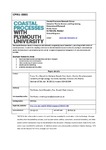Morphodynamic variability of high-energy macrotidal beaches, Cornwall, UK
| dc.contributor.author | Poate, Tim | |
| dc.contributor.author | Masselink, Gerd | |
| dc.contributor.author | Russell, Paul | |
| dc.contributor.author | Austin, M | |
| dc.date.accessioned | 2014-09-24T07:55:16Z | |
| dc.date.available | 2014-09-24T07:55:16Z | |
| dc.date.issued | 2014-04-01 | |
| dc.identifier.issn | 0025-3227 | |
| dc.identifier.issn | 1872-6151 | |
| dc.identifier.uri | http://hdl.handle.net/10026.1/3121 | |
| dc.description | The full text is under embargo until 01.04.16. | |
| dc.description.abstract |
Spatial data collected over three years are presented to assess the extent of morphological variability under seasonal and storm waves on two high-energy macrotidal beaches on the north Cornish coast. Of particular interest was the degree to which the beaches displayed bar/rip morphology and a novel approach to quantify the three-dimensionality of the beach based on the curvature of the bottom contours is adopted to identify and classify the three-dimensional beach response to changes in the dominant forcing conditions. Morphologically, the beaches range from dissipative to intermediate and are characterised by low tide bar/rip morphology which plays a key role in the nearshore dynamics and beach safety. Real-time kinematic (RTK) GPS surveys were undertaken using an all-terrain vehicle to measure the three dimensional (3D) morphology. In addition, nearshore wave data, in-situ hydrodynamic measurements, local tide gauges and Argus video data allowed detailed analysis of process-response mechanisms for long term (yearly); seasonal (monthly); storm (weekly/daily); and tidal (hourly) morphological behaviour. Both sites exhibited net long term accretion derived from the intertidal beach volume. Throughout the survey period, inter-site similarity in beach response was observed in response to storm waves, yet coupling between the seasonal wave climate and the beach morphology was not evident at either of the sites. Increased wave conditions (exceeding Hs= 4. m) during sustained storm events (>. 50. h) led to offshore transport from the beachface to the subtidal bar region. Post-storm recovery was characterised by onshore transport and the development of substantial 3D low tide morphology. Under normal wave conditions (Hs= 1.6. m), the dominant 3D features smoothed out as channels in-filled and bar prominence reduced over a period of 2-3. months. Overall, the beaches exhibited a significant storm-dominated morphological response cycle, unlike the more familiar winter/summer seasonal response. © 2014 Elsevier B.V. | |
| dc.format.extent | 97-111 | |
| dc.language | en | |
| dc.language.iso | en | |
| dc.publisher | Elsevier BV | |
| dc.subject | macrotidal | |
| dc.subject | morphology | |
| dc.subject | high-energy | |
| dc.subject | Cornwall | |
| dc.subject | beach dynamics | |
| dc.subject | storm | |
| dc.title | Morphodynamic variability of high-energy macrotidal beaches, Cornwall, UK | |
| dc.type | journal-article | |
| dc.type | Article | |
| plymouth.author-url | http://www.sciencedirect.com/science/article/pii/S0025322714000371 | |
| plymouth.issue | 0 | |
| plymouth.volume | 350 | |
| plymouth.publication-status | Published | |
| plymouth.journal | Marine Geology | |
| dc.identifier.doi | 10.1016/j.margeo.2014.02.004 | |
| plymouth.organisational-group | /Plymouth | |
| plymouth.organisational-group | /Plymouth/Admin Group - REF | |
| plymouth.organisational-group | /Plymouth/Admin Group - REF/REF Admin Group - FoSE | |
| plymouth.organisational-group | /Plymouth/Faculty of Science and Engineering | |
| plymouth.organisational-group | /Plymouth/Faculty of Science and Engineering/School of Biological and Marine Sciences | |
| plymouth.organisational-group | /Plymouth/REF 2021 Researchers by UoA | |
| plymouth.organisational-group | /Plymouth/REF 2021 Researchers by UoA/UoA07 Earth Systems and Environmental Sciences | |
| plymouth.organisational-group | /Plymouth/Research Groups | |
| plymouth.organisational-group | /Plymouth/Research Groups/Marine Institute | |
| plymouth.organisational-group | /Plymouth/Users by role | |
| plymouth.organisational-group | /Plymouth/Users by role/Academics | |
| plymouth.organisational-group | /Plymouth/Users by role/Researchers in ResearchFish submission | |
| dc.identifier.eissn | 1872-6151 | |
| dc.rights.embargoperiod | Not known | |
| rioxxterms.funder | Engineering and Physical Sciences Research Council | |
| rioxxterms.identifier.project | New Understanding and Predicting Storm Impacts on Gravel beaches | |
| rioxxterms.versionofrecord | 10.1016/j.margeo.2014.02.004 | |
| rioxxterms.licenseref.uri | http://www.rioxx.net/licenses/all-rights-reserved | |
| rioxxterms.type | Journal Article/Review | |
| plymouth.funder | New Understanding and Predicting Storm Impacts on Gravel beaches::Engineering and Physical Sciences Research Council |


